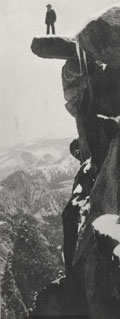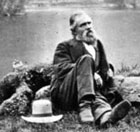My wife and I were married in Yosemite. We've had the good fortune to good back to visit many times, including a yearly Marriage Renewal Ceremony at the Chapel. Yosemite is so good for the soul. After a visit, I don't only feel renewed in my marriage, I feel renewed overall.
During those visits, we learned about Galen Clark - a remarkable story.
 Galen Clark at Glacier Point
Galen Clark at Glacier Point
Born in Shipton, Canada East (now Quebec) in 1814, Clark developed a passion for Yosemite when he first visited the area in 1855 as part of a 17-member pioneer tourist party. After suffering a lung hemorrhage and quitting his job as a packer at the Mariposa Ditch Company, he decided to either find a cure or end his days in the mountain air. Settling at the meadowlands of Wawona in 1857, Clark built a log cabin near a river ford and trail that provided access to both the Mariposa Grove of Big Trees and Yosemite Valley. The road from Wawona-an Indian word believed to mean big tree-was considered the most scenic since it included the famed view of old Inspiration Point. Clark's rest stop, soon known as Clark's Station, furnished visitors with meals, shelter, and a place to graze their horses. There, Clark engaged his guests on a variety of topics from fauna and flora to American Indian history and geology.

Within five years, Clark ascended to a critical role in the development of what would eventually become Yosemite National Park. In 1864, President Abraham Lincoln signed the Act of Congress transferring Yosemite Valley and the Mariposa Grove to the State of California as a grant reserved from settlement. Terms of the act required that the "State shall accept the Grant upon the express conditions that the premises shall be held for public use, resort and recreation; [and] shall be inalienable for all time." The grant was locally administered by a guardian representing an eight-man board of commissioners. Their first choice for the new position was Galen Clark. Throughout the next 24 years, commissioners came and went but the popular and effective Clark was retained as guardian.
The site was eventually developed into the Wawona Hotel complex that continues to serve Yosemite visitors today.

Galen Clark's spirit remains in Yosemite. He is buried in the Valley Cemetery.
George Fiske / NPS Historic Photo Collection
Despite failing as a businessman, Clark never lost his reputation for hospitality and generosity to weary travelers. “He kindly furnished us with flour and a little sugar and tea, and my companion, who complained of the be-numbing poverty of a strictly vegetarian diet, gladly accepted Mr. Clark’s offer of a piece of bear that had just been killed,” wrote John Muir in The Yosemite.
Muir met Clark at his Wawona ranch during the legendary botanist’s first visit to Yosemite. Over the years, the two outdoorsmen made many wilderness sojourns together in which Clark scrambled through thick chaparral brush in the easiest way. On one 1872 trip, Clark helped set stakes in an ice field on the slopes of Mount Maclure as part of Muir’s glacial research. Deemed the best mountaineer that Muir ever met, Clark sought few comforts when outdoors. He was even rather careless about selecting a bed for the night. “He would lie down anywhere on any ground, rough or smooth, without taking pains even to remove cobbles or sharp-angled rocks protruding through the grass or gravel,” Muir wrote.
Clark accompanied Ralph Waldo Emerson, along with Muir, during the poet’s 1871 visit to the Mariposa Grove. Clark proudly pointed out a lower branch on the Grizzly Giant that was 6 feet, 7 inches in diameter—as big as the base of any tree trunk Emerson might see in New England. Emerson was given permission to name a sequoia, which he called the Samoset Tree, after the first American Indian to contact the Pilgrims. Another sequoia was named after Clark. Reportedly, it was the first Big Tree seen by him when he entered the Mariposa Grove in 1855.
On March 24, 1910, a few days before his 96th birthday, Clark died at his daughter’s home in Oakland, California. Decades earlier he had chosen his final resting place not far from Yosemite Falls. He dug his own grave, planted seedling sequoias from the Mariposa Grove sequoias and selected a granite marker. Today, visitors can stand at Galen Clark’s gravesite in the Valley Cemetery and marvel at the growth of those sequoias amidst the expanse of his conservation efforts.
View several of Galen Clark's books online through the American Libraries Internet Archive.
- Read Indians of the Yosemite Valley and Vicinity: Their History, Customs and Traditions (1904)
- Read The Big Trees of California, Their History and Characteristics (1907)
- Read The Yosemite Valley, Its History, Characteristic Features, and Theories Regarding Its Origin (1910)
Return to Kevin and Linda page: Click Here